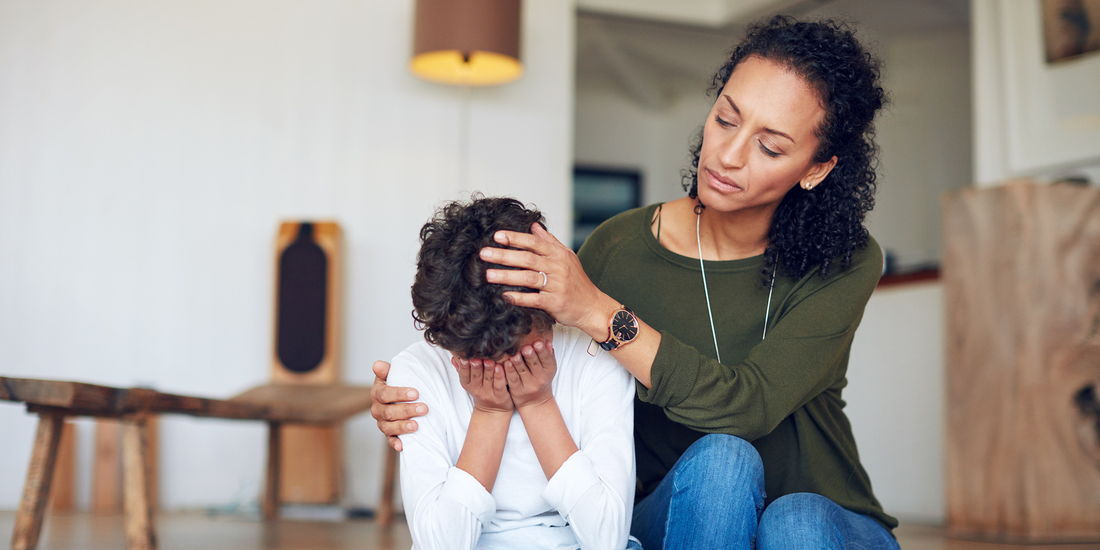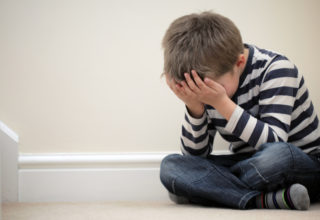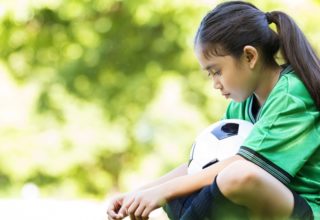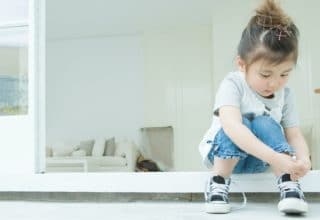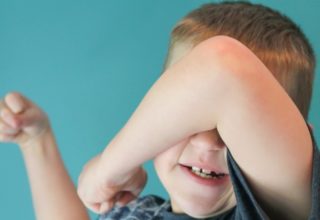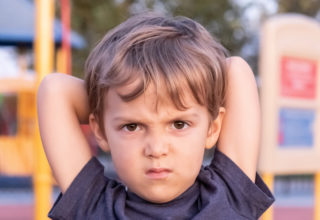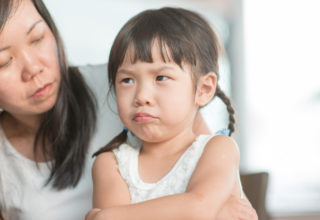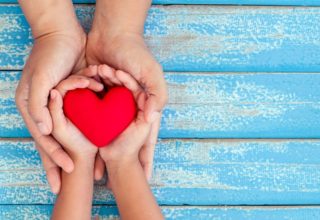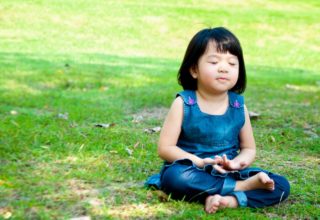Learn how to help your child handle the expected feelings related to anxiety, and how to identify when anxiety moves out of the typical realm and into something problematic.
*Note – Suggestions in this article do not replace individualized professional intervention specific to your child’s needs. If you are concerned about your child’s anxiety or want more information regarding anxiety disorders, seek professional help from a licensed practitioner, such as a pediatrician, child psychologist or mental health practitioner who specializes in working with children. The term ‘anxiety’ is broadly used to describe a range of behaviors, including anxious behavior and clinically diagnosed anxiety. There are many components to anxiety, including genetics and external triggers. In this article, we discuss supporting a child through anxious behavior.
Learn
Basic Concepts
It is normal for a child to feel anxious and worry about all sorts of things throughout their lives. Many of the feelings that underlie anxiety are common and most children will experience anxiety at some point.
- It is okay to worry – Anxiety is a normal, human experience designed to keep us alert. It can keep us safe and can help us learn, grow and be resilient.
- Anxiety is often characterized as something ‘bad’, but in fact it can be extremely helpful. For example, we would not want a child to hike on the edge of a cliff without worrying about what is below, nor would we want a child to climb a tall ladder without worrying about how they will get back down. Anxiety causes our brains to be vigilant, encourages us to be aware of our surroundings and to stretch out of our comfort zones.
- But, over-worrying can be a problem – When anxiety is persistent and chronic for a child – daily or several times a week for many weeks – and gets in the way of daily functioning, then it becomes problematic. When a child’s internal ‘alarm system’ alerts them to things that are not legitimate threats and becomes overwhelming and uncontrollable, it is a good idea to seek professional help to determine whether they are dealing with an anxiety disorder, or typical age-appropriate anxiety that many children experience.
What Anxiety Looks Like
Anxiety presents differently in different children. Anxiety in a child will also look different from anxiety in a teenager or adult.
- Physical signs – Common physical signals include: falling or staying asleep, and somatic concerns like stomachaches and headaches. (More physical signs here.)
- Some physical signs related to fidgeting or restlessness are also symptomatic of many things, including developmentally appropriate worry, nervousness or boredom, and may not necessarily imply that your child has anxiety (e.g., biting nails, sucking on hair, biting lips, picking lips, shaking legs, touching the face, etc.). These behaviors can be related to a number of issues: sensory processing, bad habits, idiosyncrasies, etc. Behaviors like these alone are not necessarily cause to believe that your child has anxiety.
- Behavioral signs – There are also behavioral signs that are seemingly disconnected from anxiety, but can in fact be the way a child’s anxiety manifests. For example:
- Lack of focus – A child who is directing a lot of mental energy towards triggers that are making them anxious may have trouble focusing.
- Irritability and anger – A child experiencing anxiety may act angry and defiant. A child whose brain perceives a threat and does not have adequate coping skills can feel frustrated, which can then lead to irritability or outright anger.
- Sometimes this anger can seem to come out of nowhere. Consider this analogy: think of a glass that is full of anxious thoughts, slowly filling over time. Suddenly that last drop can cause a dramatic overflow. Similarly, when a child overestimates a threat, their amygdala is activated and can shift into fight or flight mode (anger is related to the fight response).
- Defiance – A child who is anxious and feels unable to cope with whatever they are facing may attempt to control situations as a way of feeling less helpless and in more control.
Learn more about the other ways a child’s anxiety shows up as something else. Under your child’s anxious behavior are layers of emotions and the goal should be to better understand what is underlying their anxiety.
Do
How to Support Your Child
Recognizing that anxious behavior exists and can begin in early childhood is critical.
- First, focus on your response to your child. The actions you take to support your child can have a lasting impact on how your child understands their anxiety.
- Then, teach your child self-help, coping strategies so that they know they can take control of their anxiety.
Key Strategies You Can Use
Core Marbles
- Accept your child’s anxiety and focus on the recovery.
- Keep the anticipatory period short.
- Validate your child’s feelings.
- Notice and appreciate when your child is able to use new skills to move through anxiety.
- Model, model, model moving through anxious moments yourself.
- Be mindful of your own words and body language.
- Accept your child’s anxiety and focus on the recovery – The goal is to teach your child coping skills to move through their anxiety and to handle the stress of it, not eliminate the source of their anxiety or prevent them from experiencing it.
- It is hard to see any child experience worry, stress and unhappiness, but attempting to avoid or eliminate things that trigger your child’s anxiety is both impractical and not sustainable. It also reinforces your child’s anxiety over time and communicates to them, “You should be worried about _____; we’re avoiding or eliminating it because it is too much for you to handle.” Any short term relief by avoiding a hard situation grows exponentially into a long-term downside as your child matures.
- Focus on helping your child develop the positive experience of pushing through hard things to help decrease their anxiety. i.e., repeatedly facing a trigger, developing the skills to move through it and coming out on the other side. Experts call this the ‘habituation curve’.
- A groundbreaking study out of Yale University found that counseling parents of anxious children is as effective as working directly with the child. The research demonstrates that parents who tend to accommodate their child’s anxiety do not improve the situation and actually reinforce the child’s anxiety. When parents are taught to supportively step back and help their child face their anxiety, it helps their child overcome it.
Avoid protecting your child from their worries and avoiding or eliminating triggers.
- Keep the anticipatory period short – Most anxiety is related to expecting what is upcoming, so minimizing the amount of time a child spends in this anticipatory period is helpful.
- For example, if your child is anxious about going to the dentist, do not engage in a long conversation about the dentist several hours before the appointment. This ensures your child does not spend too much time over-worrying about the event.
- However, it is important to also not blindside your child without a short processing period. Give your child the necessary amount of time for them to process what is upcoming, gather their coping skills and self-help tools, and make a plan with you, if needed.
- You know your child best to judge the optimal length for this anticipatory period. Keep iterating and checking in with your child after each event to learn what is most effective for them.
- For example, if your Kindergartener was feeling anxious about their first day of school, at the end of that first week, you could ask, “I know it was really hard to say goodbye on that first day. What do you think we could have done differently to help you feel more comfortable?”
- For example, if your child is anxious about going to the dentist, do not engage in a long conversation about the dentist several hours before the appointment. This ensures your child does not spend too much time over-worrying about the event.
- Validate your child’s feelings – It is always important to validate your child’s feelings (there will likely be conflicting feelings at the same time), some of which your child may not be able to articulate themself. The goal is to make sure your child: 1) feels heard and understood; and 2) knows that you are there to support them.
- For example, you could say, “I know you’re worried about the first day of school. That’s normal! And I’m here to help you. We can make a plan to get through this.” This sequence communicates to your child that their feelings are okay, and that together you can take control of the situation and move through it.
- In this example, a ‘plan’ could include talking through what feels scary about ‘school’ for them. Is your child worried that they do not know their teacher? Will they be with new friends? Will they be in a new physical environment? Are they afraid of missing you? If you can get to specifics by naming the precise problem, it will be easier to strategize for concrete, helpful coping tools.
- For example, you could say, “I know you’re worried about the first day of school. That’s normal! And I’m here to help you. We can make a plan to get through this.” This sequence communicates to your child that their feelings are okay, and that together you can take control of the situation and move through it.
- Notice and appreciate when your child is able to use new skills and move through anxiety – Be specific about what you noticed. For example, you could say:
- “I know you were really nervous about going to school today. I saw how you closed your eyes and did some deep breathing before you got out of the car. Way to go!” or;
- “I noticed how you panicked when you realized that you were late. I heard you frantically shuffling stuff, then I heard you stay really still and count backwards ‘5-4-3-2-1’. Great job on centering yourself!”
- Praise being open-minded to learning new things and pursuing passions.
- Model, model, model moving through anxious moments yourself – Let your child see how you cope with anxious feelings so they see it is normal to deal with anxiety at some point. You can state what you are feeling (physically and emotionally), how you are going to handle it, and what coming out the other side looks and feels like.
- Research proves that anxious behaviors can be learned and that anxiety can be transmitted from parent to child, independent of genetics. The good news: parents can reduce their child’s anxiety by modeling effective coping skills.
- For example, you could say, “I have a big presentation today. Every time I have to speak in front of a large audience, my heart beats really fast, my stomach feels like it is filled with butterflies, my knees shake and I speak very quickly. But I’m excited to tell my people what I know and I’m curious to see how they react. I’m going to rest well the night before and practice my presentation one final time in the morning. When it’s done, I will feel really proud that I did something hard.”
- Be mindful of your own words and body language – Children notice visual and social cues, and sometimes, adult body language or tone of voice can indicate something unintentional to a child. Consider eliminating:
- Any imposing language such as, “I am so disappointed in you.” or, “It makes me sad when you…” Children are not responsible for their grown-up’s disappointment or sadness, and yet many children earnestly want to please their grown-up which can create anxiety; and
- Any body language or tone of voice that contradicts the words you might say when your child ‘performs’ (e.g., when they play a sport, meet new people, try an activity, etc.)
If Your Child Does Not Want to Talk About Their Anxiety
There are many reasons that your child may not want to openly speak about their anxiety or avoids the subject altogether with you. Their feelings about the topic may range from shame, to embarrassment, to confusion, to fear, to not understanding what is physically happening in their bodies and minds. Try to normalize talking about anxious behaviors and the unexpected in your everyday, including:
- Make it a habit to ask, “What was unexpected about your day?” (instead of “How was your day?”);
- Talk about moments when you were anxious and how you processed it;
- Model how you cope in-the-moment when an anxious moment presents itself for you; and
- Actively notice and point out how characters in books or TV shows that are anxious and how they move through it.
The key is to keep sharing the message with your child that anxious feelings are normal and that they can handle them. When a child learns to recognize their triggers, know their symptoms and how to cope with them independently (first with your support, then independently), they are able to take control of their anxiety.

Paige Abramson Hirsch, Teacher + Education Consultant + Parent
Paige Abramson Hirsch is an elementary school teacher turned lawyer turned educational administrator and educational consultant supporting school districts and charter schools. Paige studied psychology with a focus in child development at Tufts University and holds a JD/M.Ed from the University of Minnesota. Paige previously served on the Board of HAND, a non-profit for bereaved parents. She lives in San Carlos, California with her husband and two young children, whom she thanks for providing her with endless opportunities to analyze child development and behavior!
When your child begins having anxious thoughts, empower them with practical self-help strategies and coping skills so that they can...
If you want to raise a child who grows up to be a resilient, problem-solving, persistent and adaptable adult, let...
Let’s double-down on how to translate *growth mindset* into something tangible with your child. We’re focusing on how to teach...
*Yet* – Three letters that may change your child’s outlook on life, even among the youngest learners. Learn how the...
‘Sensory processing development’ is vital to understanding how children learn. It is deeply studied among early childhood experts, but not...
Foundational skills for teaching your child to be more independent and to be in charge of themself and their learning....
A go-to list of calming strategies that your child can independently use to get back on track when they feel...
Learn why it is important for your child to be able to identify their emotions, and help them build their...
It may feel like a number of impulsive behaviors are seemingly normal for children. But what is ‘normal’? In this...
Brain differences make it hard for a child to control their behavior. Understanding your child’s impulsive behaviors can help you...
Discover how your child’s brain and body are emotionally and physically processing their anger, and strategies and tools to help...
Identify what anger looks like across different developmental ages and understand what is a typical anger expression and what is...
Key strategies and tools to use before, during and after your child’s angry outbursts – all in a simple printable...
The benefits of mindfulness and how it can help your child thrive. How to naturally and authentically infuse mindfulness into...
Help your child to control their thoughts by making Mindful Minutes a routine. Your step-by-step guide on why, how and...
A breathing exercise to help your child move through the rocky moments in their day. Easy to do and remember....
Empower your child to manage their emotions and regain control in heated situations with *STOP!*
‘Executive functioning’ is a phrase often cited when talking about child development. But what does it really mean and how...
Nuts + bolts; let’s get tactical. Now that we’ve baselined the three primary processes of executive functioning, let’s look at...
Make a go-to place for your child to find comfort and safety when their internal engines feel out-of-sorts. Whether you...
